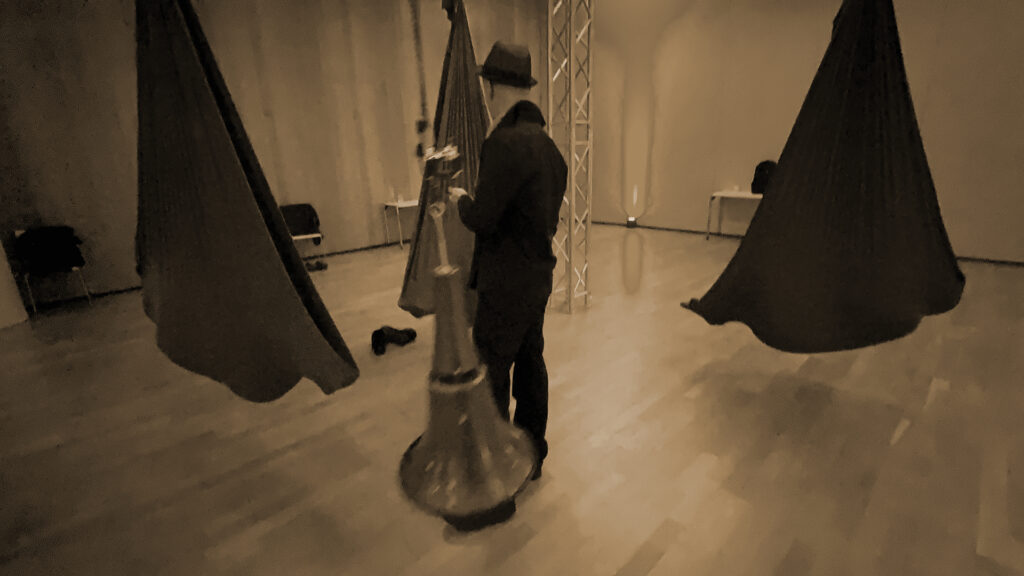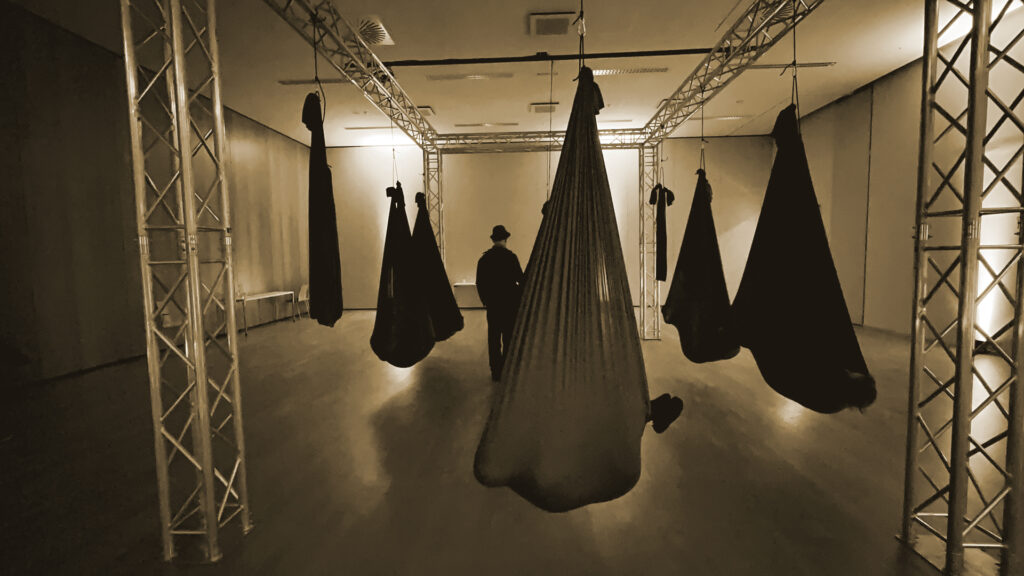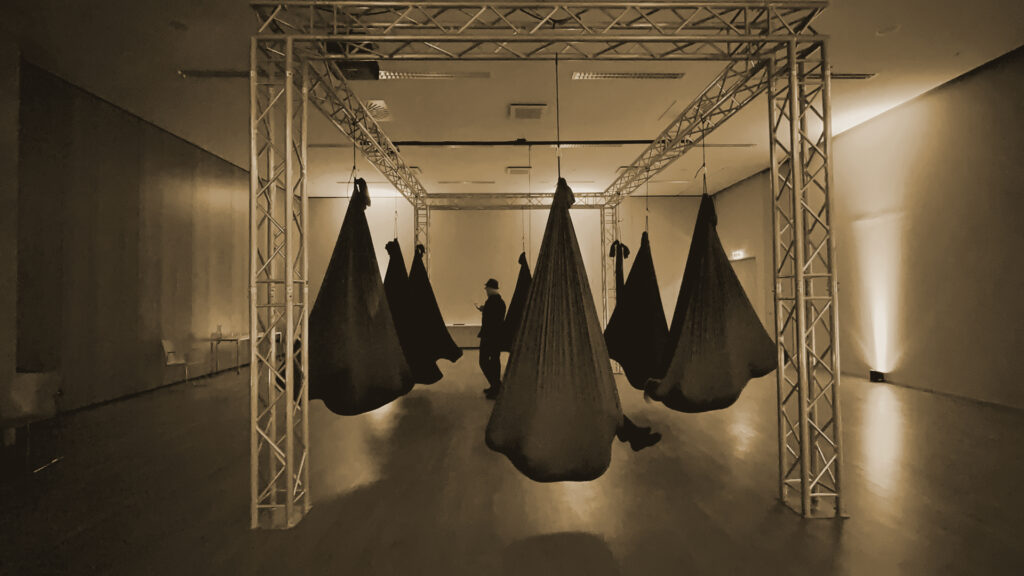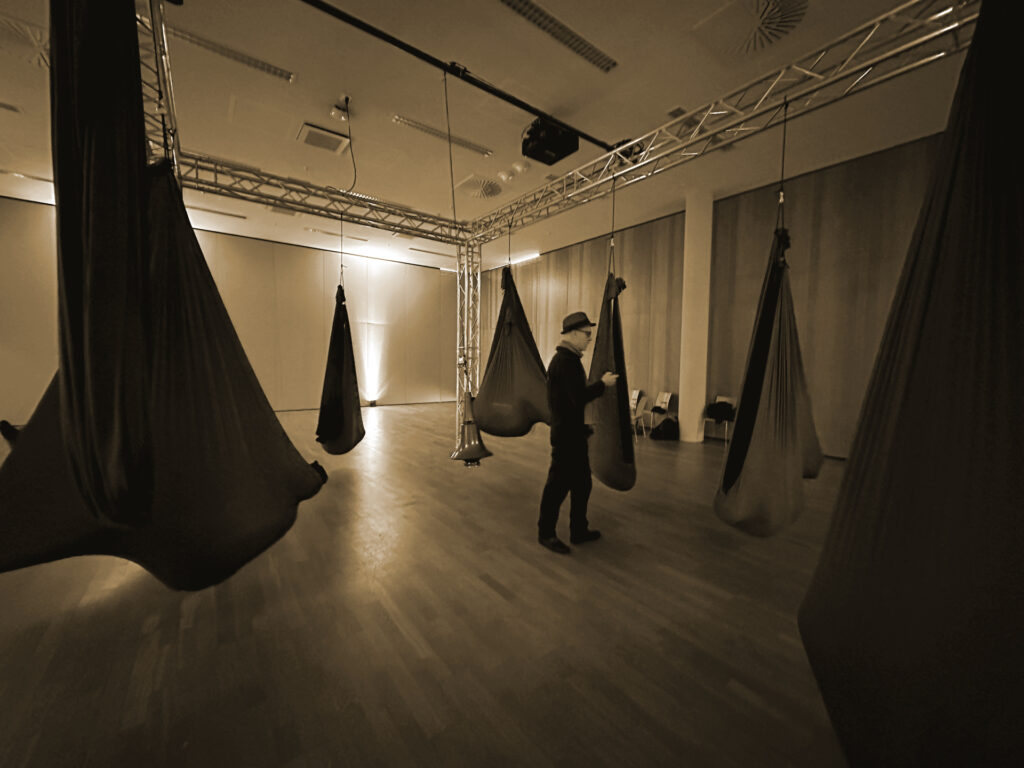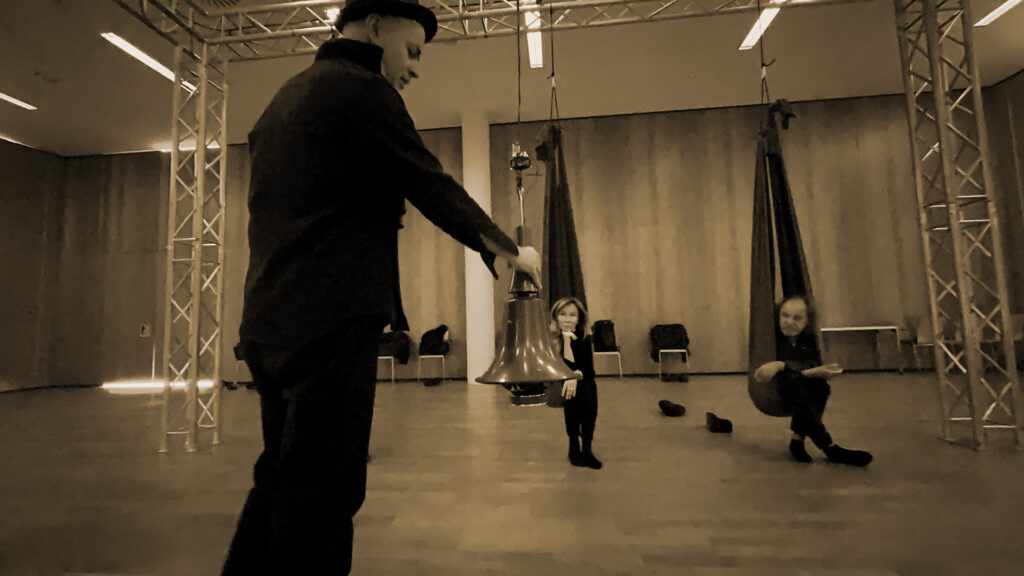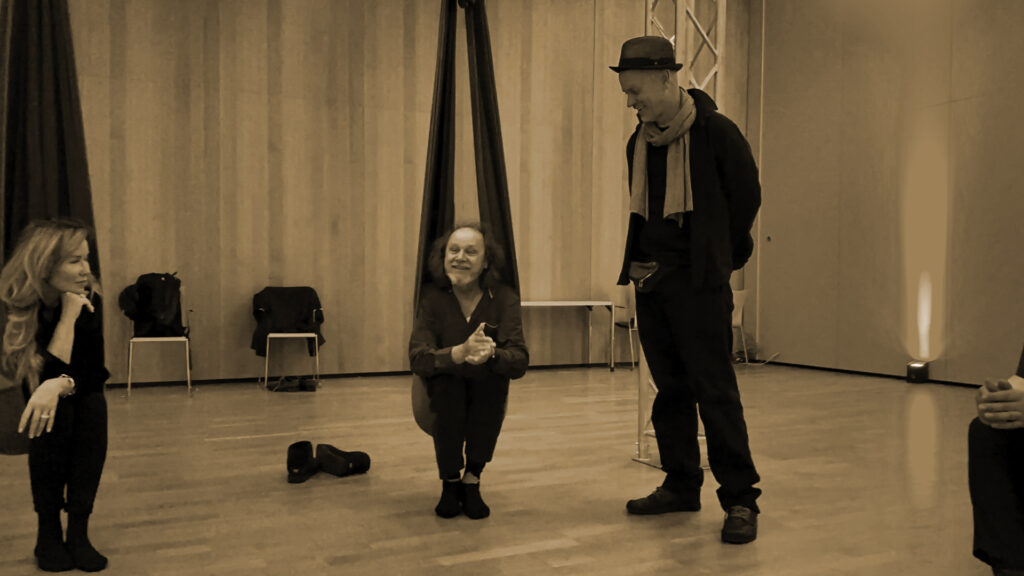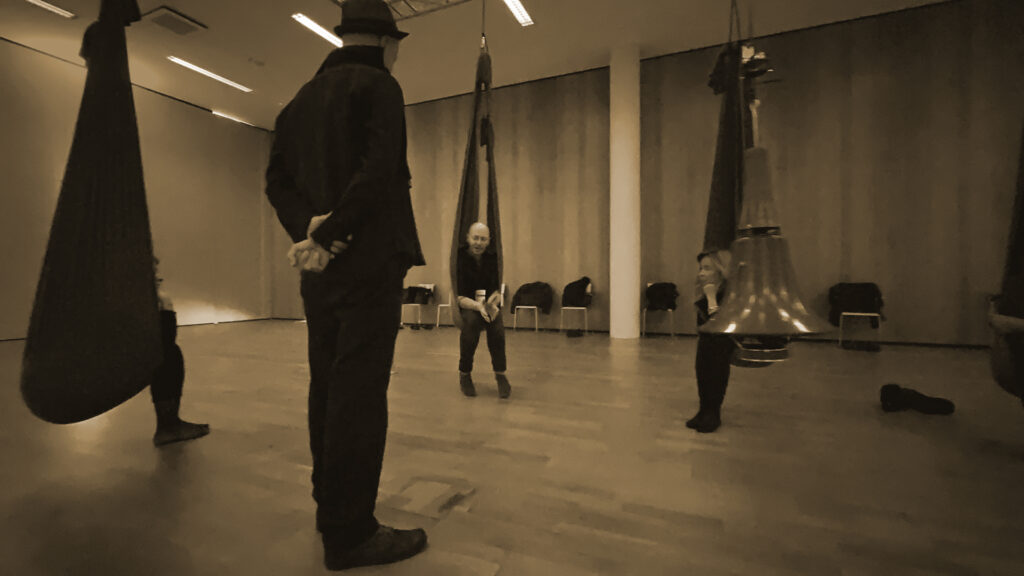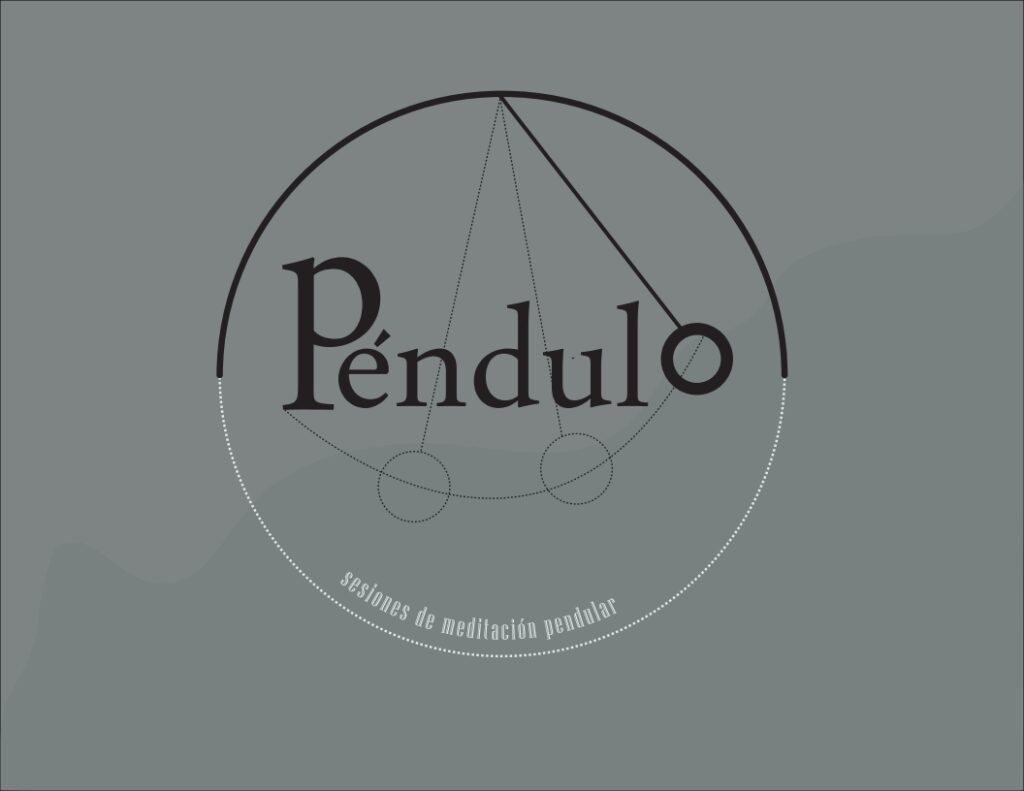
Pendulo #Salz21 home of innovation https://www.salz21.at/en/
The main intention of the experimental protocol in oscillatory meditations is to achieve states of lucid hypnagogia, a state of consciousness where one experiences vivid sensory phenomena and hypnagogic hallucinations while maintaining a degree of self-awareness and clarity of mind.
In oscillatory meditations, achieving this state is done through the use of a cloth hammock that moves gently like a pendulum, creating a feeling of weightlessness and encouraging the meditator to let go of physical tension and mental distractions. Focusing on the sensation of oscillation and allowing the mind to wander can induce a state of lucid hypnagogia.
Oscillatory meditations use gravity and the pendulum movement as a means to contemplate impermanence, emphasizing the transience and fluidity of existence.
During meditation, it is common for the mind to be distracted by opaque and vague thoughts, ideas, and images, making the practice difficult. By focusing on the breath, sound, and in this method, gravity, the aim is not to pay attention to these mental images and thoughts, but rather to observe them, recognize their quality, and return to the present moment.
The pendulum becomes a technological tool that allows for mindful attention to gravity, one of the most present and recognizable forces of nature, but often ignored. Albert Einstein’s theory of relativity shows us that gravity is not just a force that attracts objects, but also the curvature of space and time due to mass and energy. This curvature affects everything that exists in the universe, from subatomic particles to entire galaxies. Gravity unifies the universe into a single entity, where everything is connected and in constant interaction. In this context, the practice of pendulum meditation seeks to help us focus on gravity as a force present within ourselves and everything around us, and thereby develop a greater awareness of our interconnectedness with the universe.
During meditation, by focusing on the present moment and perceiving the subtlety of gravity, as well as contemplating the impermanence of the moment, we can let go of thoughts and mental projections. When we access the hypnagogic state, one of these mental projections transforms, and the image becomes clearer, more vivid, and more detailed, and we become immersed in this environment with all our senses. The practice aims to help us have this experience lucidly, recognize it, and continue the experience in contemplation.
In lucid dreams, by extending our perception of time, gravity ceases to be one of the fundamental forces of the material universe, allowing us to levitate, fly, and experience other realities in a lucid manner. The practice of pendular meditation aims to help us reach hypnagogia and detach from the material reality while remaining aware of it and learning to integrate expanded states of consciousness.
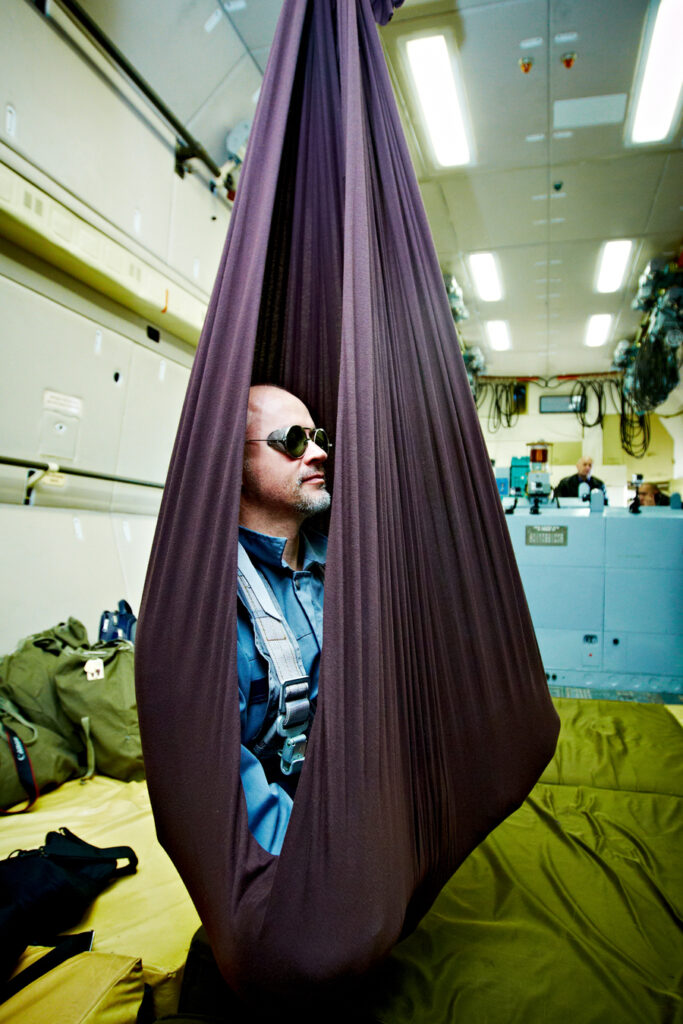

In 2013, Ale de la Puente and Nahum Mantra brought together a group of artists at the Laboratorio Arte Alameda to discuss the possibility of traveling to Roscosmos, the Russian space agency, to perform artistic experiments in zero gravity. This meeting was a very special moment. Understanding that we would have a unique opportunity to experiment with gravity was very motivating. So many thoughts and questions I had about this phenomenon of nature could be synthesized into a current and real experience.
I have been practicing meditation and lucid dreaming for several years. Much of my net-art production is related to the perception of the concrete, oneiric, and digital realms based on hypotheses of speculative realism.
During these years, a constant personal search in the practice of lucid dream states has been to detach myself from gravity and float. If our existence is subject to this super force, why can’t we detach ourselves from it in dreams? Can this happen in deep meditations?
From the announcement they made to us, I began to investigate more about gravity and non-ordinary states of consciousness. I remembered reading about an aerial Yoga practice that was beginning to boom in New York. I researched this modality of Yoga and set up a cloth hammock at home to practice in. The hammock is made of stretchy fabric that hangs from a point on the ceiling by climbing ropes, and is used to practice postures developed especially for this system. I began to develop an alternative model of meditation based on the pendulum movement of the body in the hammock.
I developed this practice for two years, and it was part of the experiments I performed in the gravity laboratory of the Russian space agency. Meditating in zero gravity was a set of scientific, mystical, and artistic methods used to speculate on reality.
The collective work of this experience was part of the exhibition “The Gravity of Matters,” which opened in 2015 at the Laboratorio Arte Alameda and toured several countries.


Pendular Sound Artifact
A pendulum instrument has been built, a sound artifact with an amplified horn and a microcontroller that measures in real-time the variables of an accelerometer and gyroscope sensor. These variables are used to change the pitch of the reading of a wavetable. As the artifact oscillates in pendulum movement, on the one hand, the Doppler effect enters, which is related to the movement of the sound source, and on the other, the variations in pitch can be understood as a metaphor for the curvature of space and time.
An illusion about perception of listening is to understand the passage of time through the pitch of sounds, whether they accelerate or slow down. In meditation, listening is essential to be in the here and now. For sound to exist, there must be transformation; in a static universe, sound does not exist. Sound is pure transformation, sinusoidal waves. It is the most direct reference to the passage of time and exists as such in the moment of consciousness.
In this meditation, as the body oscillates gently, the sound and its origin become enveloping, they are everywhere and nowhere at the same time.
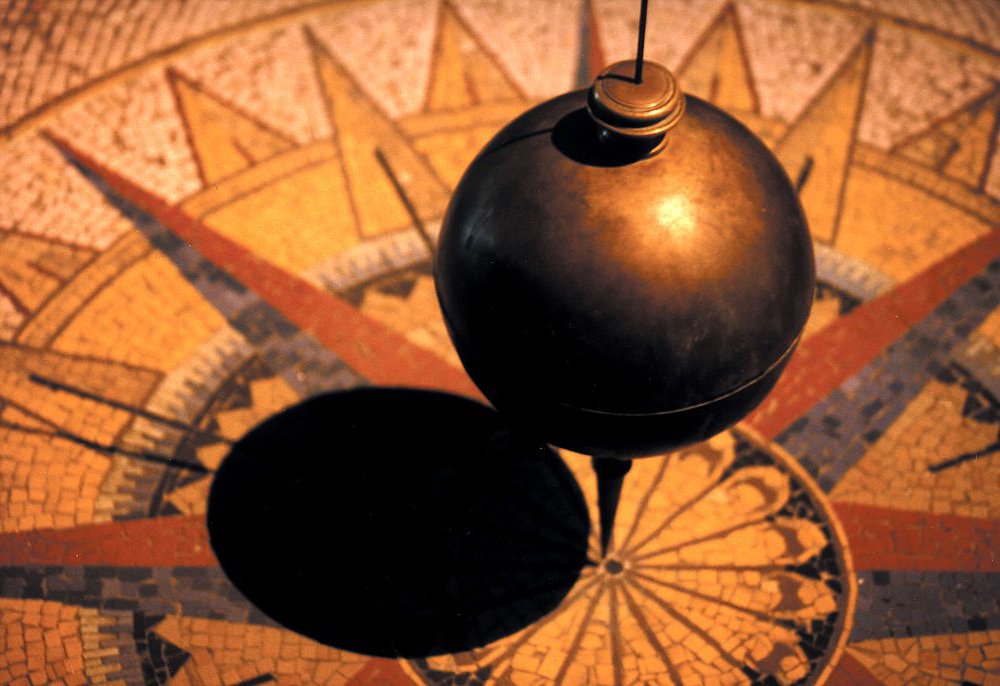
The pendulum is the simplest instrument to understand the most complex problems of nature, for centuries it has been a useful tool for various fields of knowledge, the isochronic property of its movement is a simple but fundamental system of nature, it unites the rhythm of time with the existence of matter. Its study spans centuries. From classical to quantum physics it is fundamental to the understanding of nature.
The study of the pendulum established the laws of the free fall of objects by Galileo Galilei, forming a fundamental part of the mathematics he performed, it helped establish Newton’s laws of conservation of energy, and with its use established the gravitational constant and allowed him to determine the speed of sound.
The motion of the pendulum can also be described in terms of Einstein’s special relativity, this theory states that time and space are two aspects of the same entity known as space-time. According to special relativity, time is dilated in areas with high energies or high velocities, which means that time passes more slowly in these areas, space-time is considered a unified entity in which time and space are interrelated. This means that time can deform or curve due to the presence of mass or energy. The motion of the pendulum is a good metaphor to understand the curvature of space-time and how it can deform due to gravity.
In cosmology, the oscillation of the pendulum is closely related to the motion of celestial bodies; it is an example of periodic motion, i.e. a motion that repeats at regular intervals of time. Influenced by the gravitational force, its oscillatory motion allowed it to recognize the rotation of the earth as it was attracted by gravity.
In the same way, for millennia, using mystical methodologies and subjective experimental protocols, the pendulum has been a fundamental tool for reaching non-ordinary states of consciousness. The subtlety of its oscillations has been employed as a system of hypnotism and as a paranormal tool to assist the perceptual systems of the consciousness, bringing awareness to the subtle phenomena of reality. Space-time unifies matter, everything is interconnected and in constant interaction, the frequencies of nature exist in the process of consciousness, sound exists when we listen, light when we observe and gravity only when we fall or only pay attention to it in those accidental circumstances.
Inducing lucid hypnagogia during meditation in a pendulum hammock while attending to the cosmos and gravity can be a powerful way to explore the unconscious mind and gain insight into the interconnectedness of all things. Hypnagogia is a state of consciousness that occurs when the body is falling asleep and the mind is in a transitional state between wakefulness and sleep. During hypnagogia, one may experience mental phenomena such as visual imagery, sounds, and bodily sensations. Lucid hypnagogia refers to a state of hypnagogia in which the individual is aware that they are in a dream-like state and can manipulate and control the dream.
The movement of the pendulum can be used as a metaphor for the interconnectedness of all things and the interplay between time and space. The pendulum swings back and forth, connecting the past and the present, just as the cosmos connects all parts of the universe through the force of gravity. The movement of the pendulum can also be seen as a representation of the cycle of life, with the pendulum swinging from birth to death and back again.
Incorporating the concept of the pendulum and cosmology into meditation can deepen the experience and help the individual tap into the unconscious mind. The pendulum hammock provides a soothing and comfortable environment for meditation, allowing the body to relax in a protective cocoon and the mind to let go of thoughts and worries. By focusing on the movement of the hammock and the influence of gravity and the sensation of the soft fabric against the skin, the individual can enter a state of deep relaxation and become more receptive to the unconscious mind.
Stephen Laberge develop the WILD technique ( wakeup induced Lucid dream ) to be conscious in the instant we start to dream, this instance is hypnagogia, when we are meditation imaginary and troughs are constant, the technique is not to attend this thoughts by focusing on impermanence , must of this imaginary is opaque , during meditation this images in the moment of hypnagogia became hyper real, the resolution and light quality drastically change, this is the cue to stay lucid in the dream state, to recognize this change , and continue the meditation in this place, also the force of gravity change, you can levitate at will.
- http://meditatiosonus.info/
http://arc-data.net/info/espherica/
http://arc-data.net/SonoLuminiMente/
http://arc-data.net/inductokhor
http://arc-data.net/sonoshock/CHAE
http://arc-data.net/AquaPlanetarium
Hyperhumanism showcase curated by Carl Hayden Smith featuring artists 220 and Arcangelo Constantini
SALZ21 HOME OF INNOVATION
Overall theme of the showcase:
Humans are not evolutionarily equipped to deal with the level of complexity that the rapid rise in disruptive technology is creating. ‘Design or be designed’ is the new mantra. Instead of outsourcing our human becoming to the machine and becoming Transhuman how do we use techniques and technologies to help us become more human? This is the basis of Hyperhumanism. How can we use technologies to visualise and understand not only the inner worlds of our own bodies but also the complexities of the wider environment. Using the concepts of Hyperhumanism rather than Transhumanism as the basis of our technological designs, we can enable an eco-social feedback loop for regenerative behaviour change.
More info:
https://museumofconsciousness.space
https://www.cyberdelicsociety.com
https://www.ravensbourne.ac.uk/people-and-stories/meet-team/carl-smith
Exhibition 2: Lucid Hypnagogia experience: Pendulum by Arcangelo Constantini
Hypnagogia is a state of consciousness that traditionally occurs when the mind is in a transitional state between wakefulness and sleep. During hypnagogia, it is common to experience enhanced creative abilities, and access to mental phenomena such as visions, sounds, and unusual bodily sensations. Incorporating the concept of the ‘pendulum hammock’ allows us to achieve this state of lucid Hypnagogia within a very short duration of time. The pendulum hammock provides a soothing and comfortable environment for meditation, allowing the body and mind to relax in a protective cocoon. By focusing on the movement of the hammock and the influence of gravity and the sensation of the soft fabric against the skin, the individual can enter a state of deep relaxation and become more receptive to the unconscious mind unlocking their creative potential.
The main intention of the experimental protocol in oscillatory meditations is to achieve states of lucid hypnagogia, a state of consciousness where one experiences vivid sensory phenomena and hypnagogic hallucinations while maintaining a degree of self-awareness and clarity of mind. In oscillatory meditations, achieving this state is done through the use of a cloth hammock that moves gently like a pendulum, creating a feeling of weightlessness and encouraging the meditator to let go of physical tension and mental distractions. Focusing on the sensation of oscillation and allowing the mind to wander can induce a state of lucid hypnagogia. Oscillatory meditations use gravity and the pendulum movement as a means to contemplate impermanence, emphasizing the transience and fluidity of existence.
